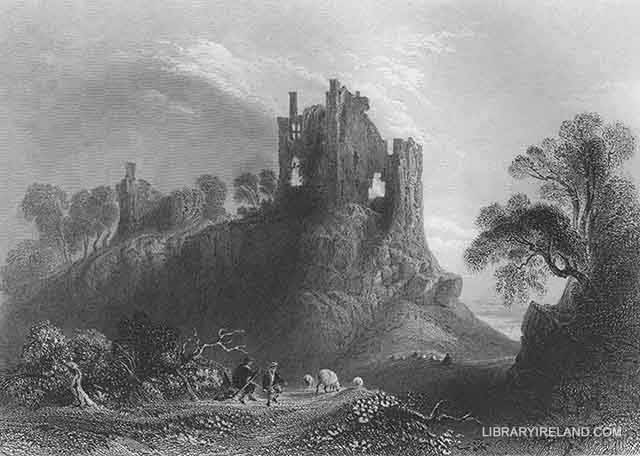Castle of King John, Limerick
Descending from the cathedral tower with more difficulty than we ascended, from the dilapidated condition of the narrow stone staircase, we kept down, the Shannon on the old-town side to visit the ancient CASTLE OF KING JOHN, the fine round towers of which still show nobly in every view from the other shore. New walls are built in with the old, and the castle is now used as a police-station, but it preserves its grandeur amid all the modern tenements which surround it.
The old town, through the narrow streets of which we had made our way, is a very different place from the newer Limerick, and as Mr. Inglis remarks, a person entering the city by this avenue, and taking up his quarters there, would infallibly set down Limerick as the very vilest town he had ever entered. "The city is composed," says an historical writer, "of the English-town, the Irish-town, and the New-town-Perry. The first stands on the northern side of the river, being separated from the latter by a narrow arm of the Shannon, which embraces the English-town in its entire circumference; and on the north-west side of the great branch of the river, in the county of Clare, is the extensive and populous suburb of Thomond-gate. The English-town has all the antiquated appearance of a close-built fortress of the latter part of the seventeenth century: its venerable cathedral, narrow streets, and lofty houses, chiefly built in the Dutch or Flemish fashion, are said to give it a considerable resemblance to Rouen, in Normandy. This gloom is however relieved at various openings by a view of the cheering waters of the Shannon, while the vicinity of the canal, and the verdant fields and gardens which skirt the borders of the Abbey-river, afford a pleasant promenade to its dense population. The ground on which the New-town is built is rather elevated, and the soil is generally gravelly and dry.
The streets are spacious, cut each other at right-angles, and are occupied by elegant houses and merchants' stores, constructed of brick and limestone, for which the neighbouring district supplies the finest materials. A more superb city-view can hardly be presented to the eye than the range of buildings from the new-bridge to the Crescent, a distance little short of an English mile, including Rutland Street, Patrick Street, George's Street, and the Tontine; and its interest will be greatly heightened when the line of buildings is continued from the Crescent along the military road, and the projected square built on its left. Shops, tastefully laid out and richly furnished, line these streets, while others diverge to the right and left, which are chiefly occupied by the residences of the gentry.
At every opening to the westward salubrious breezes from the Shannon inspire health and vigour; and a walk to the quays is amply compensated by the scenes of busy traffic there presented, and the various enlivening prospects which meet the eye. Here the packet-boat from Kilrush is landing her joyous passengers, whose nerves have been braced and spirits exhilirated by some weeks' residence on the shores of the Atlantic at Kilkee or Malbay. There turf and fish-boats are discharging their cargoes, which are rapidly conveyed by herculean porters to the dwellings of the consumers, amidst various specimens of Munster wit, sometimes delivered in the native language, and sometimes in Anglo-Irish, On the west are seen the distant towers of Carrig-o-gunnel Castle, and the Pool, where the larger ships ride at anchor in perfect security, while many a skiff cuts the blue wave. On the east appear the mill of Curragour, built in 1672, and its rapid current, which roars and eddies amidst rocks of various shapes and sizes; the bridge of Thomond, hoary with age; and the ivy-mantled turrets of King John's Castle, backed by the mountains of Clare and Tipperary. The city contains nearly fifty public edifices, about one half of which stand on the south-west side of the river. The liberties comprehend about sixteen thousand Irish acres, extending from three to four miles south, east, and west of the old city walls. The parish of St. Michael's, or the New-town of Limerick, is divided from the old city by a branch of the Shannon: it is described as containing two thousand houses and ten thousand inhabitants, and as comprising all the wealth and trade of the city."


